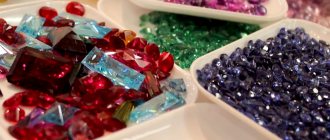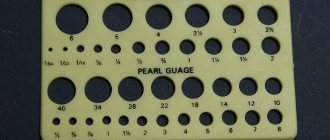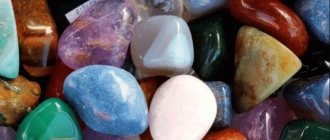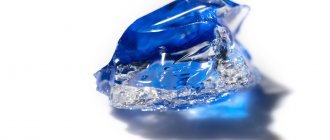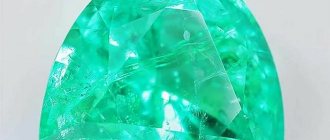In sunlight, the stone takes on a greenish tint; in artificial light, it becomes reddish or purple. Alexandrites from a deposit in the Urals are considered standard: on the world market they are called “Russian”.
Alexandrites are mined only in a few places on the planet, so jewelry-quality samples are highly valued. Fortunately, man has long learned to create precious stones no worse than natural ones. Synthetic alexandrites resemble the best Ural specimens: clean, bright, with a strongly pronounced reverse.
History of synthesis
Alexandrite is a type of the mineral chrysoberyl. The first attempts at its synthesis were made in the second half of the 19th century: the French chemist Jacques Joseph Ebelmain was able to obtain chrysoberyl crystals measuring 5-6 mm in size. He was the first to synthesize a mineral compound that has no analogues in nature, but with the optical properties of alexandrite.
To obtain synthetic chrysoberyl, Ebelman and his students calcined beryllium and aluminum oxides in the presence of mineralizers. The crystals turned out to be small, with numerous flux inclusions. They were not suitable for jewelry purposes.
In the mid-twentieth century, attempts were made in the USA to obtain synthetic alexandrite from a solution in a melt. At first the crystals were small, but by 1964 it was possible to develop a synthesis method suitable for use on an industrial scale. In 1972, the Americans K. Kline and D. Patterson filed a patent for the method of flux from a solution in a lithium molybdate melt.
In 1970, the Japanese company began producing synthetic alexandrites obtained by the Czochralski method - by drawing a crystal from a melt. They were called "kresent-vert" and "inamori". Alexandrites "inamori" had a cat's eye effect - a running glare on the surface.
Currently, alexandrites are synthesized using the zone melting method and the Czochralski method. The resulting crystals are used for both jewelry and technical purposes. Synthetic alexandrites of the best quality are obtained by the Czochralski method.
From the history of alexandrite
1840 The largest cluster of alexandrite crystals to this day was found in the Emerald Mines. After the discovery, Count Lev Alekseevich Perovsky bought it for his collection. The aggregate consists of 22 dark green crystals of various sizes, in association with mica and opaque pale green beryl prisms between alexandrite crystals. The sample dimensions are 25 x 14 x 11 centimeters and weighs 5724 grams.
1842 Niels Gustav Nordenskiöld (1792 -1866), Finnish mineralogist, publishes a scientific description of alexandrite, substantiates the mechanism of color change in chrysoberyls.
1856 Prince Pyotr Arkadyevich Kochubey (1825 – 1892) buys out Perovsky’s mineralogical collection, including the largest intergrowth of alexandrite crystals. The specimen is now part of the mineralogical collection of the Fersmanov Museum and is known as “Kochubey’s druse.”
*“Kochubey’s druse” measuring 22 x 13 cm with perfectly formed crystals measuring 6 x 6 cm, dark green in color, but almost opaque
1861 Eliphas Levi (birth name Alphonse Louis Constant) (1810 -1875), French writer and magician, in his book “The Key to the Great Mystery” explains the duality of the color of alexandrite by the duality of human blood - venous and arterial - and calls alexandrite “a symbol of charm of our time, which cleanses and strengthens blood vessels.”
1909 The first synthetic corundum with a color-changing effect was grown and has since been used as an imitation of alexandrite. Its colors vary from violet to reddish-purple.
1912 Alexandrite is listed as a “Stone of the Month” by the American National Association of Jewelers.
1916 Jan Czochralski developed a method for filling synthetic ruby crystals. The method is used to this day to produce simulants of alexandrites, known as “Czochralski Alexandrites.”
1922 Alexander Evgenievich Fersman (1883 – 1945), a famous Russian mineralogist and gemologist, reports that 2,000 kilograms of alexandrites and 20,000 kilograms of rough emeralds have been mined in the Emerald Mines since 1834.
1937 By creating a giant mosaic panel made of gems, which would display all the victories of the social industry, the Communist Party of the USSR decided to celebrate the 20th anniversary of the October Revolution. This idea belonged to G.K. Ordzhonikidze, People's Commissar of Heavy Industry of the USSR.
The map of industrialization of the USSR is the entire Soviet Union as it was at that time on a scale of 1:1,500,000. The panel measures 27 square meters and is made of fifty thousand fragments. Pieces of gems, selected according to shades, amaze with a magnificent play of color and are adjusted to each other with amazing precision.
*here - more about this unique panelMap of colored stones
*The name of Leningrad is inscribed with Alexandrite
1973 Creative Crystals Inc, a company from San Ramon, California (USA), patents the production of synthetic alexandrites by flux growth.
1977 Allied Corporation, New Jersey (USA) is developing a method of introducing chromium impurities into chrysoberyl, followed by their activation with a laser, which leads to the appearance of an “Alexandrite” effect. Subsequently, stones made using the Czochralski method are used to produce alexandrites.
1992 The name Alexite is given to Czochralski's synthetic alexandrites. The samples were studied in 1992, the GIA said. The stones showed a strong color change effect from reddish-purple under incandescent light to bluish-green under daylight or fluorescent light. Czochralski's alexandrites turned out to be very similar to natural Brazilian alexandrites.
Alexandrite is the name given to chrysoberyl, which changes color depending on the light source under which the stone is observed. The most popular and valuable colors are blue-green in daylight and purple-red under incandescent light. Stones with weak, medium and strong discoloration are identified as alexandrites, while stones with very slight discoloration are generally considered chrysoberyls.
But for many jewelry lovers, alexandrite is a purely nominal name, because it can rarely be found in jewelry - this gem is very expensive, its deposits are small, and any jewelry with alexandrite is an exclusive item, available only to a select few. In terms of level, it is equal to the first group of precious stones, and its extraction and transportation are monitored no worse than diamonds and rubies. As a rule, almost all stones have inclusions, cracks and opacities - absolutely defect-free alexandrites are almost never found and their cost, especially if the crystal is large enough, is absolutely astronomical. The largest alexandrite crystal contains only 66 carats. There are also translucent alexandrites with a “cat’s eye” effect (cymophanes) - they are cut in a cabochon, so that a six-rayed star blooms in the middle; such specimens are valued lower, but even their cost reaches several thousand dollars per stone.
If you buy alexandrite – what should you pay attention to?
Its most important value is its color qualities. In the old days it was called a stone whose “morning is green and evening is red,” because in the light of the sun it plays with all shades of green, and under an electric lamp its color becomes red. And the most remarkable thing is that the stone is characterized by the effect of pleochrysm: if you look at it from different angles, then its edges will differ from each other, shimmering from bluish-green to yellowish-green, then from orange-red to lilac. It seems that you are standing on the shore of a pristine Siberian lake, in which the branches of centuries-old trees are reflected, and if you raise your head, the scarlet sunset will sparkle with all its colors... For Russia, this color scheme is especially relevant - after all, these are the colors that have long been considered our national ones.
But, of course, first of all, it is necessary to look at the quality and strength of the color change. A strong change where the colors are bright and attractive under any kind of light is most desirable. There are many stones that have either a nice green color in daylight or a nice “pinkish red” under incandescent light, but unfortunately not both! But because alexandrite is so rare, even stones with weaker or less attractive color variations remain sought after and highly prized. The degree of color change of gemstones is usually assessed according to four levels: very weak, weak, moderate (medium), strong.
Sometimes you come across raw alexandrite that is not suitable for cutting into classical shapes due to its very strong inclusion, almost opaque. But if such stones have a strong enough color changing effect, they are cut into cabochons. Alexandrite cabochons often exhibit a strong “châteauyansi” effect - a cat's eye effect.
Clarity, quality of cut and size are the next most important parameters after color in determining the value of alexandrite. Large stones are always rare and, as a result, more valuable. The quality of the cut and the proportions given to the stone are very important, but even more important is maintaining a balance between weight, cut shape, and level of color change.
The skill of the cutter is of fundamental importance when working with alexandrite. Since stones often contain irremovable inclusions (those inclusions that cannot be lost during the cutting process), the choice of shape and type of cut depends only on the skill of the cutter, in which the inclusions in the stone will be located in areas where they will be least noticeable. And, accordingly, they will have the least impact on the overall appearance of the stone. The value of such a stone, all other things being equal, increases several times.
Which alexandrites are better?
A question that has no answer! Russian alexandrites are traditionally very respected and valuable on the world market. But, unfortunately, the supply of alexandrites to the world market from Russia has practically ceased in recent decades.
Fortunately for alexandrite connoisseurs, fine stones are available from several deposits in other countries: Brazil, India and Tanzania produce the vast majority of modern alexandrites, which are also found in Sri Lanka and Madagascar. Stones of the highest quality are extremely rare, but all these deposits sometimes provide humanity with exceptional stones.
Brazilian stones typically have better “redness” under incandescent light, while Indian stones are known for their excellent bluish-green colors under daylight. The largest stones are now mined in Tanzania and Madagascar, and some of the African alexandrites are exceptional in the totality of their characteristics. Such stones are usually transferred to the best craftsmen in Israel or Belgium for cutting.
A few years ago, a new deposit of alexandrites was discovered in Orissa, India. It will not be surprising if, after some time, Orissa alexandrites are recognized as the best in the world for their rare purity, very bright saturated colors and exceptionally strong color changing effect. Especially considering that today this field already looks like it has exhausted its reserves.
The production of alexandrites in Russia, which once had excellent raw materials, has today almost completely ceased.
Which colors are better?
And there is no clear answer to this question! The best color is first of all the one you like :)
Therefore, there is no generally accepted opinion about which colors of alexandrite are the best. Some experts consider the main advantage to be the bright red color under an incandescent lamp, while others recognize only the dark blue-green color as the height of perfection. The truth, as always, is somewhere in the middle. My personal opinion is that what matters first is the balance of colors, and that the greens of daylight and the bright reds of artificial light should be equally good, saturated. It is this factor that is decisive when evaluating alexandrites.
According to most GIA experts, the following colors are the most valuable for alexandrites:
– in daylight, G 5/2 (Very lightly saturated medium green) and vslbG 5/2 (very lightly saturated medium very weak bluish green) colors. – under an incandescent lamp R 5/3 (weakly saturated medium red) and slpR 5/3 (weakly saturated medium slightly purplish red) colors.
Some stones may look very good only in daylight or only under an incandescent lamp, and their value and therefore cost will be significantly lower.
But the most important parameter for determining the value and cost of alexandrite is the buyer’s opinion. If a person wears alexandrite of the color that he likes most, then he will be the owner of the most valuable (for himself) stone.
Is alexandrite real?
Synthetic alexandrites grown from flux have been known for over 100 years. Over the past more than 30 years, mass production of synthetic laboratory alexandrites and doublets based on them has been established. Grown, synthetic alexandrites and doublets are very common (the majority of all alexandrites on the modern internet market) but can be easily identified by any more or less experienced gemologist. All high-quality artificial alexandrites are certified.
Recently, there have been a lot of requests for the examination of alexandrites purchased in Alexandria, Egypt. It must be said right away: in Egypt there are no deposits of alexandrites in particular, or chrysoberyls in general! But there is a huge demand among unusually “educated and literate” tourists! Therefore, it should be clearly understood: all “Alexandrian” alexandrites are synthetic stones. To identify them, a gemologist just needs to “look” at the missing inclusions. Gemological science does not yet know natural alexandrites free from inclusions.
Soviet alexandrites
About products that were manufactured and purchased in the USSR. During the entire existence of the USSR, NOT A SINGLE NATURAL ALEXANDRITE WAS SOLD through the official jewelry retail chain! These stones were considered by all Soviet rulers as the “property of the republic” of the highest category, and the very fact of the ancient purchase of alexandrite in the store of our Motherland is a 100% guarantee of its “synthetic nature”.
There is one more factor that allows you to identify “Soviet” alexandrite without the participation of a gemologist. The color scheme of all such alexandrites necessarily contains a violet color, which has never been found in natural alexandrites.
What causes the color change in alexandrites?
Alexandrite is a trichroic gemstone that can absorb and reflect light differently along each of its three optical axes. However, trichroism is not at all responsible for such a remarkable property of alexandrites. The color change is a result of the presence of chromium +3 ions and the way they are embedded in the crystal lattice. In rubies, the absorption spectrum line for chromium +3 ions corresponds to a wavelength of approximately 550 nanometers, and in emeralds, accordingly, approximately 600 nm. In alexandrite, the wavelength of the absorption line of chromium +3 ion corresponds to approximately 580 nm. That is, almost halfway between a red ruby and a green emerald! Daylight is polarized with a predominance of blue and green colors, respectively, and alexandrite appears green. In artificial light, the predominant polarization is red, and alexandrite appears red under a lamp or candle.
If a mixed light source is used to examine alexandrite, for example, illuminating it with a flashlight in daylight, then the stone will show a mixed color.
A few basic truths:
1. Natural natural alexandrite MUST change color (pleochroism + alexandrite effect).
2. The “standard” color of natural natural alexandrite is ONLY green in daylight and ONLY crimson-pink-red-purple or yellow in artificial light. Those. There can be no violet (in general) or pure indigo in daylight. Just as there cannot be a lack of pleochroism and the alexandrite effect.
3. A stone weighing more than 3 carats, just like a stone purchased in the USSR before 1973, is a direct indication for going to a gemologist for examination.
4. The cost of natural natural alexandrite is high - from 5 thousand to 37 - 40 thousand dollars per 1 carat.
But that's not all. Unfortunately, at the moment, artificial alexandrites grown using the Czochralski method or hydrothermal method, etc. are counterfeited no less often. At best, they imitate alexandrites, including artificial ones (we are talking about them now), with synthetic corundum with the addition of vanadium or a vanadium coating. By the way, this imitation option for synthetic alexandrites is not the worst, because It is based, albeit synthetically, on a precious (and therefore at least beautiful) stone, and the price for such artificial “alexandrites” is not much lower than for the artificial alexandrites themselves.
The color range of artificial alexandrite, depending on the strength and source of light, ranges from almost deep black with blue-green, indigo-gray and purple-raspberry-violet sparks to bright amethyst pink, up to a rich purple-ruby color.
There are also coarser and cheaper fakes, the main raw materials for which are glass or crystal with the addition of vanadium. And if you probably won’t be able to distinguish genuine natural alexandrite from cheaper vanadium grossular garnet (yes, there are those too) and artificially grown alexandrite, and genuine artificial alexandrite from artificial corundum or spinel with an alexandrite effect, you will not be able to recognize You can easily create a “changeable” piece of glass.
Glass changes color depending on the lighting in a different range: – with bright artificial (warm) – deep pink-violet – with bright artificial yellow-white (mercury incandescent lamps) and “cold” white – faded gray-blue without a green tint – in daytime of any intensity - pink-lavender-violet. Well, in addition, glass cannot “play”, i.e. remains monochromatic at any angle of inclination (no pleochroism) and in any lighting, even mixed.
And if in the first two options (dependence - color / lighting) there is some resemblance to artificial alexandrites, corundums and spinels with an alexandrite effect, then it is by the last two signs that you can determine that this is glass or an artificial gemstone.
And if you still doubt the nature of the stone (which is possible, since the stone is extremely sensitive to the brightness of light and its color even depends on the angle of inclination, which means it permanently plays and changes color) - do the following experiment: take the stone out to daylight light (but not in direct sunlight!) and look through it at a white sheet of paper. If you hold genuine artificial alexandrite in your hands, you will definitely see a green tint through the thickness of the stone). Well, of course, the price gives away the glass. All artificially grown precious stones are sold only in carats, and not in pieces/cm, threads, bundles, etc., i.e. the price of artificially grown precious stones is disproportionately higher than that of ordinary vanadium glass.
What is the difference between alexandrite and chrysoberyl? (this question is interesting for those who would like to understand how exactly gemstone appraisers work).
Indeed, chrysoberyl and alexandrite can sometimes be very difficult to differentiate. Because Stones with slight color changes can be called both alexandrites and chrysoberyls, what is the difference? What is the difference? Where is the border between chrysoberyl and alexandrite?
As we already know, the color change in alexandrite depends on the presence, distribution and concentration of chromium. And the color of yellow, green or brown chrysoberyl depends on the presence of iron ions. Accurate spectral analysis will reveal the differences, since chromium and iron have completely different characteristic spectra. The absorption lines of “chrysoberyl” iron, responsible for its colors, are located in a fairly wide range of frequencies centered around 4450 Angstroms in the blue-violet region of the spectrum. While the absorption lines of “Alexandrite” chromium are in the red-orange region of the spectrum. Such an analysis is the main diagnostic method for differentiating alexandrite and chrysoberyl.
Fluorescence is another feature that can help differentiate between alexandrite and chrysoberyl. Chrysoberyl gets its yellowish color from iron and does not usually show fluorescence. Red fluorescence of alexandrite can be observed using the “grid filter” method. This method is a reliable way to confirm the “Alexandrite” status of a stone. The only problem is that not all alexandrites have noticeable fluorescence.
*alexandrite (double). Emerald Mines, Wed. Ural, Russia. 1.5 cm. Drawing by V. Slyotov and V. Makarenko
**the Museum of the Mining Institute in St. Petersburg contains pure transparent crystals measuring 6 x 3 cm from the deposits of the Urals; in the photo these are No. 2 and 3
The healing properties of alexandrite are in some ways similar to those of amethyst: it serves both as a medicine and as a prevention of diseases associated with painful addiction to alcohol, nicotine, and drugs. In general, alexandrite is believed to remove toxins from the body and is especially good at cleansing the circulatory system. It is good to wear it during the period of recovery or rehabilitation after a serious illness, injury or surgery - alexandrite promotes rapid regeneration and bringing the physical condition to harmony. Alexandrite has an excellent effect on skin diseases, including leprosy; in addition, it cures problems with the spleen and pancreas.
When wearing alexandrite, you should carefully monitor how often it changes color: constant “mutations” may indicate a sharp change in blood sugar levels, being a harbinger of diabetes. A change in color can also occur due to a sharp change in the owner’s mood: by carefully observing the stone, you can learn to prevent emotional breakdowns, especially since alexandrite in general helps to calm, relieve stress, and gain mental balance.
Energetically, alexandrite promotes harmony between the mental, physical and astral planes. This is a prophet stone that brings flashes of insight to its owner and warns of future possible problems. Hindus call alexandrite a stone of prosperity, believing that it attracts wealth and honor.
It is believed that alexandrite is able to absorb the energy of the Sun and generously bestow it on its owner. Maybe that’s why it is sometimes called the stone of strong passions and it is believed that the one who wears it often finds himself captive of love and jealousy...
Yes, this stone is not easy, it is shown to people who are strong, integral and self-confident; it will lead them forward and bring them happiness, good luck and joy in all areas of life. Those. alexandrite is a so-called “male” stone: it fosters in a person independence and the ability to steadfastly withstand the ups and downs of life, therefore alexandrite is contraindicated for housewives, people engaged in boring and routine work, those who do not have ambitions and prefer a quiet and calm life - it is a talisman successful businessmen, military leaders, rulers, in general - for active people who travel frequently. Due to the changing color, it is perfect for representatives of creative professions, and specifically for those who manage creative processes, for example, producers, directors, event organizers, advertising business owners working in the field of IT technologies. Alexandrite should be worn in a ring or on the head, in the form of earrings or a hoop (tiara), and it is best to combine jewelry with alexandrite at the same time as jewelry with green or red garnet, so that the bright impact of alexandrite on your life is slightly softened: in this combination, alexandrite acts on hidden emotions, helps create a joyful mood, openness, the manifestation of a thirst for life, pacifies the soul, makes the owner peaceful and accommodating.
Jewelry with this stone must be removed before going to bed. They are usually placed in water at night, and a few sips are taken in the morning. (With)
Products from them:
2017-04-13Irina Vladimirovna
- 5
- 4
- 3
- 2
- 1
Rating: 5 , Votes: 5
How to grow alexandrites
To obtain synthetic alexandrites, low-quality natural stones are used. The crushed raw materials are heated and melted. To obtain the desired color, vanadium and chromium oxides are introduced into the melt.
The synthesis process is carried out in a special container, or crucible. It must withstand high temperatures, so it is made of refractory metals - for example, iridium. This platinum group metal costs 3 times more than gold, which affects the final cost of synthetic alexandrites: they cannot be called cheap, although they are cheaper than their natural counterpart.
During the synthesis process, a seed of sapphire or other stone, mounted on a vertical rod, is placed in the melt. Then it gradually rises, rotating and turning, and “pulls” part of the melt behind it. This hardens to form an alexandrite crystal. The cycle is repeated several times until the melt is exhausted.
Famous stones
Alexandrites weighing more than one carat are rare. The best one-carat examples can cost upwards of $20,000.
For a century and a half, the largest nugget was considered to be a stone weighing 531 carats, which was found in 1839.
Larger nuggets were discovered not so long ago - in the 90s of the 20th century. In 1992, a crystal weighing 880 carats of jewelry quality was found at the Malyshevsky deposit “Ural Emerald Mines”. In 1993, a druse of crystals weighing 348 grams was found there.
And in 2000, a giant nugget weighing three thousand carats (total weight - 597 grams) was discovered in a Gokhran warehouse. The stone, called “Patriot,” was valued at $170,000.
A unique alexandrite was arrested for non-payment of wages to workers. The government refused to buy Patriot. Later, its price dropped by more than 10 times. "Patriot" was sold for 15 thousand dollars to private hands. Where the nugget is now, one can only guess...
Many Ural alexandrites are found abroad, in museums and private collections. In the Geological Museum. Vernadsky has a collection of 82 alexandrites, which was donated by collector Yuri Kozlov.
Chemical properties
Alexandrite is not only a beautiful stone, but an extremely hard one. On the Mohs scale its hardness is 8.5. This means that the mineral is practically not scratched, and jewelry with it can be worn every day.
Synthetic alexandrite has the same hardness as natural alexandrite. Its edges do not wear off during wear and remain smooth and neat. And if jewelry with an expensive natural stone may be unsafe to wear every day, then with a synthetic one it is completely safe.
Certificate
Since synthetic stones are quite common, and their price is much lower than natural ones, you can request a certificate of quality upon purchase. It is better, of course, for such a document to be issued by a well-known gemological laboratory with a proven reputation.
A thorough study of the composition of a given stone will help determine not only its real value, but also the country of origin, which can be reflected in the expert report issued on the stone.
Typically, alexandrites are not treated; in some cases, however, they can be impregnated with resin to hide cracks. This procedure will also be reflected in the expert report. Synthetic alexandrites today are produced using several methods, some of which can produce stones that are virtually indistinguishable in appearance from the real thing.
In addition, in appearance, alexandrites can be confused with some types of garnet, as well as with sapphire, which has the property of changing color. The most common are alexandrites, which were sold in large quantities in the USSR and were not such at all. The products were made with inserts made of synthetic corundum or spinels with pleochroism.
Thus, such a certificate will help you be sure that the stone you are purchasing is alexandrite.
Comparison of characteristics
When evaluating alexandrite, the color, severity of the reverse, clarity, weight and quality of cut are taken into account. For example, low quality natural stones weighing 3-5 carats
cost on the world market from $600 per carat. Alexandrites of the same mass, but of excellent quality - from 17 thousand dollars per carat and above. Large stones are valued even higher: the record is about 70 thousand dollars per carat.
Synthetic alexandrites are graded for the same characteristics. They cost much less.
Color
In daylight, alexandrite displays a palette of shades ranging from yellow-green to green and bluish-green. Yellowness makes the stone cheaper. The most valuable are alexandrites, which turn green or bluish-green when exposed to natural light.
Under artificial light, the stone takes on a reddish color, sometimes with an orange or purple tint. Red color without additional shades is the most valuable.
Synthetic alexandrites have purer colors than natural ones. This is due to the absence of iron impurities in the crystal. In daylight they look green without a yellow tint, in evening light they look crimson. Some stones also exhibit a cat's eye effect.
The cost of natural alexandrite also depends on how pronounced the color change is. It can be strong, medium or weak. Synthetic alexandrites are characterized by a strong reverse: in this they are comparable to the best Ural specimens.
Purity
Most natural alexandrites have minor inclusions - single points, gas-liquid veils, microcracks. They are not always visible to the naked eye, but they reduce the cost of the stone.
Synthetic alexandrites obtained by the Czochralski method are very pure. They contain almost no inclusions.
RusGems alexandrites were grown precisely by the Czochralski method according to the principle of recrystallization
Weight
Natural alexandrites are usually small: stones weighing less than 2 carats are common on the world market. Larger specimens are found, but much less frequently.
The Czochralski method makes it possible to grow really large crystals - both for jewelry and for technical purposes. The weight of individual specimens reaches 0.5 kg or more.
Cut shape
For alexandrite, the shape and quality of the cut are important: it should emphasize the color and optical effects inherent in the stone. The most popular options:
- "oval";
- "circle";
- "pear".
Alexandrites with a cat's eye effect, as well as opaque stones, are treated with cabochons.
Alexandrites RusGems in different cuts
Natural stones often do not have an ideal cut: in order not to cut off too much material, the cutter deliberately deviates from the standard - for example, skips some of the faces, or changes their angles. This negatively affects the visual perception of alexandrite and reduces its value.
Synthetic stones have a standard cut. The master does not need to save on material, and therefore the proportions are precisely adjusted.
Signs of natural and fake gems
Since there are very few crystals of natural origin left. Synthetic minerals are replacing them in the jewelry and technical fields. By purchasing any of these options, you become the owner of a valuable specimen, but you don’t want to buy a cheap piece of glass for a lot of money.
Several obvious signs of distinguishing a fake from a precious element:
- natural stone always changes color;
- the “classic” color of alexandrite mined in jewelry mines is green under the sun’s rays and red-crimson under a lamp;
- the price for a real gemstone ranges from $5,000 to $40,000 per 1 carat.
In addition to counterfeiting a natural mineral, it often happens that crystals grown using the Czochralski method or hydrothermally are counterfeited. Synthetic corundum with the addition of vanadium is not the worst counterfeit option. But glass with the addition of the same chemical element is a scam for a lot of money. You can find out in more detail how artificial stones differ from natural ones by reading the article “Real alexandrites: how to distinguish natural stone from imitation.”
via
How to distinguish synthetic alexandrite from natural one
The differences between synthetic and natural alexandrite are noticeable under a microscope. Gemologists focus on the number and nature of inclusions. The easiest to recognize are stones synthesized by the Czochralski method - they are very pure. In addition, synthetic alexandrites exhibit stronger reversal and fluoresce red in ultraviolet.
Cat's eye stones produce a faint fluorescence - orange-red on the inside, and pale yellow on the surface. They are also distinguished using a microscope. Synthetic alexandrites are dominated by fine silty particles, while natural ones are dominated by tubular and needle-shaped inclusions.
Gemological dossier of the stone
Color spectrum:
Color varying from green in various tones to red in various tones, from green in various tones to yellow in various tones
Refractive index: 1.741 – 1.760
Chemical composition: BeAl2O4
Hardness: 8,5
Density: 3,73
Lattice type: prismatic
Origin: Tanzania, India, Russia, Madagascar, Sri Lanka, Zimbabwe, Zambia.
Samples of untreated alexandrite:
How to distinguish synthetic alexandrite from imitation
There is a myth that in Soviet times a huge amount of jewelry with alexandrites was sold. Ural precious stones were used as inserts, and they cost mere pennies. Unfortunately, this is not so: the stones were not natural, not from the Urals, and not alexandrites.
In jewelry, several imitations with a color changing effect are used:
- synthetic corundums;
- synthetic spinel;
- doublets;
- cubic zirconias;
- nanotals.
Synthetic corundum is the most successful imitation. A crystal colored with vanadium turns pale green in daylight, and pink in artificial light. It can be recognized by its color palette, inclusions in the form of bubbles, as well as a narrow, clear line in the blue region of the spectrum.
Synthetic spinel was used to imitate alexandrites in the USSR. It is distinguished using a refractometer. Spinel is characterized by the absence of birefringence, a significantly lower refractive index, and a less diverse and plausible range.
Doublets are made from garnet and glass. The garnet top imitates the redness of alexandrite, while the glass top imitates the green. They differ from the original in hardness and other physical properties, and are also inferior in gloss.
Cubic zirconia has almost twice the density of alexandrite. In synthetic crystals, inclusions and growth lines will be noticeable under a microscope, but not in artificial cubic zirconia and nanotals.
How to determine the origin of a crystal
If the gem does not have a document, it is not an alexandrite. In this case, it is worth figuring out what type of artificial stone is chosen for the product. The properties of alexandrite help to establish the origin: a range of colors, pleochroism, indifference to ultraviolet radiation (the gem sometimes fluoresces slightly red), a weak reaction to magnets.
Alexandrite
Synthetic imitation
It is easy to distinguish a natural mineral from a synthetic one by the following characteristics: artificial is often larger than three carats, it has increased purity, and the internal bubbles are spherical (drop-shaped in natural ones).
Alexandrite. It is indifferent to magnets and fluoresces brightly orange in ultraviolet light.
Spinel. The most popular artificial “understudy”, which can be distinguished by the following characteristics:
- in daylight, a range of shades without yellow;
- in the sun, violet dominates, without greenery and bright red tints;
- the price is several times less than that of alexandrite.
The cost of artificial spinel is comparable to amethyst, citrine, and aquamarine.
Corundum. During the day, a bright yellow color appears, which is barely noticeable in alexandrite.
It is possible to determine the authenticity of such crystals at home only to a first approximation.
Natural gems
Minerals with “Alexandrite” characteristics are used as imitation: chromium content and pleochroism effect.
Natural alexandrite
You can recognize the stone yourself:
- Ruby. Visually indistinguishable from the original, the range of shades includes orange. The cost is not much lower, so imitation is rarely used.
- Tourmaline. Pleochroism depends on viewing angle, not lighting.
- Grenades, pyropes. A rare imitation. Garnet has no blue tints; the crystals are attracted by a magnet. Pyropes lack yellowness and multi-colored glare.
- Sapphire, spinel. Deprived of the daytime alexandrite scale.
- Andalusite. The colors change when you turn the stone.
Zircon, amethyst or spodumene are so different from alexandrite that the imitation is visible even to an inexperienced connoisseur.
Glass
The easiest way to distinguish alexandrite from a fake of this type is:
- shimmers like a rainbow in the light;
- Easily scratched by a needle.
Artificial material does not have pleochroism. The colors are brighter, but not as deep.
Is synthetic alexandrite better or worse than the original?
The main advantage of synthetic alexandrite over natural alexandrite is price. Although due to the high cost of production it cannot be called completely cheap, it is still much cheaper than the original. Visually, the stone is indistinguishable: to see the differences, you need a microscope.
Alexandrite synthesized by the Czochralski method has pure and bright colors. It exhibits a strong reversal: it turns from red to green when the lighting changes, and vice versa. Natural stones with such a pronounced color change effect are rare.
Synthetic alexandrite is practical. If you love this amazing stone, you can wear jewelry with it every day without worrying too much about possible loss. Jewelry with natural alexandrites, which cost fabulous amounts of money, will most likely remain in the box most of the time.
